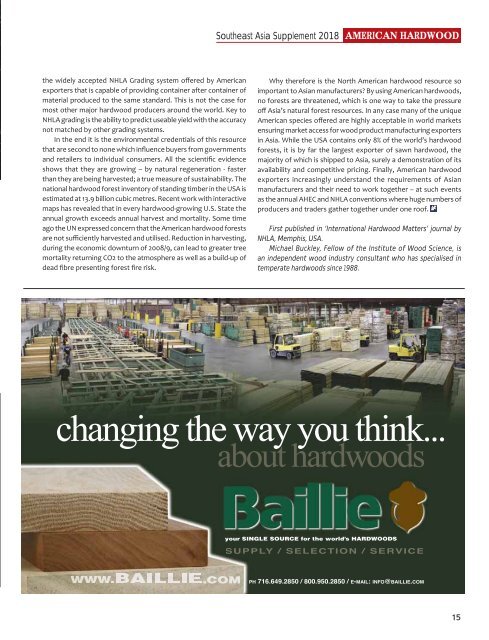American Hardwood Supplement 2018
Published in collaboration with the American Hardwood Export Council, this publication brings to light the latest updates and activities of US hardwood suppliers within the South East Asia region.
Published in collaboration with the American Hardwood Export Council, this publication brings to light the latest updates and activities of US hardwood suppliers within the South East Asia region.
Create successful ePaper yourself
Turn your PDF publications into a flip-book with our unique Google optimized e-Paper software.
Southeast Asia <strong>Supplement</strong> <strong>2018</strong><br />
AMERICAN HARDWOOD<br />
the widely accepted NHLA Grading system offered by <strong>American</strong><br />
exporters that is capable of providing container after container of<br />
material produced to the same standard. This is not the case for<br />
most other major hardwood producers around the world. Key to<br />
NHLA grading is the ability to predict useable yield with the accuracy<br />
not matched by other grading systems.<br />
In the end it is the environmental credentials of this resource<br />
that are second to none which influence buyers from governments<br />
and retailers to individual consumers. All the scientific evidence<br />
shows that they are growing – by natural regeneration - faster<br />
than they are being harvested; a true measure of sustainability. The<br />
national hardwood forest inventory of standing timber in the USA is<br />
estimated at 13.9 billion cubic metres. Recent work with interactive<br />
maps has revealed that in every hardwood-growing U.S. State the<br />
annual growth exceeds annual harvest and mortality. Some time<br />
ago the UN expressed concern that the <strong>American</strong> hardwood forests<br />
are not sufficiently harvested and utilised. Reduction in harvesting,<br />
during the economic downturn of 2008/9, can lead to greater tree<br />
mortality returning CO2 to the atmosphere as well as a build-up of<br />
dead fibre presenting forest fire risk.<br />
Why therefore is the North <strong>American</strong> hardwood resource so<br />
important to Asian manufacturers? By using <strong>American</strong> hardwoods,<br />
no forests are threatened, which is one way to take the pressure<br />
off Asia’s natural forest resources. In any case many of the unique<br />
<strong>American</strong> species offered are highly acceptable in world markets<br />
ensuring market access for wood product manufacturing exporters<br />
in Asia. While the USA contains only 8% of the world’s hardwood<br />
forests, it is by far the largest exporter of sawn hardwood, the<br />
majority of which is shipped to Asia, surely a demonstration of its<br />
availability and competitive pricing. Finally, <strong>American</strong> hardwood<br />
exporters increasingly understand the requirements of Asian<br />
manufacturers and their need to work together – at such events<br />
as the annual AHEC and NHLA conventions where huge numbers of<br />
producers and traders gather together under one roof.<br />
First published in ‘International <strong>Hardwood</strong> Matters’ journal by<br />
NHLA, Memphis, USA.<br />
Michael Buckley, Fellow of the Institute of Wood Science, is<br />
an independent wood industry consultant who has specialised in<br />
temperate hardwoods since 1988.<br />
your SINGLE SOURCE for the world’s HARDWOODS<br />
15


















